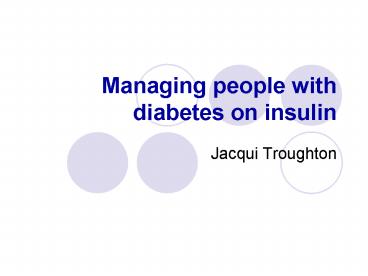Managing people with diabetes on insulin - PowerPoint PPT Presentation
1 / 29
Title:
Managing people with diabetes on insulin
Description:
To give you an overview of the insulin's available, their ... Poor control of post prandial glucose. Simplicity; may limit weight gain. Metformin with OD ... – PowerPoint PPT presentation
Number of Views:395
Avg rating:3.0/5.0
Title: Managing people with diabetes on insulin
1
Managing people with diabetes on insulin
- Jacqui Troughton
2
Aims of presentation
- To give you an overview of the insulin's
available, their actions and potential insulin
regimens - Implications of insulin choice and treatment
regimen on lifestyle advice
3
Whos on insulin therapy?
- All people with Type 1 diabetes
- People with Type 2 diabetes on maximum tablets
- People with Type 2 diabetes with
contraindications to OHA e.g renal failure, poor
tolerance - Gestational Diabetes
- Post acute MI (DIGAMI)
- Acute illness/ infection
4
Normal Insulin Profiles
Basic Requirements
What happenswhen you eat
After a meal
Just to function normally
5
Normal Insulin Profiles
6
Types of insulin
- Short (Soluble)
- Rapid (Analogue)
- Intermediate (Isophane)
- Long (Lente)
- Long (Analogue)
- Mixtures (Biphasic)
7
Short acting
- Human Actrapid (from Dec 2005, available only in
vials) - Humulin S
- Insuman Rapid
8
Characteristics of short acting insulin
- Injected 15-30 minutes before food
- Onset of action within 30- 60 minutes
- Peak action 2-4 hours
- Duration of action 6-8 hours
9
Action profile of a short acting insulin
insulin activity vs. time (h)
10
Rapid acting
- Humalog Insulin Lispro
- Novo Rapid - Insulin Aspart
11
Characteristics of rapid acting analogues
- Injected immediately before food, but may be
given during or shortly after - Onset of action within 15 minutes
- Peak action 30-45 minutes
- Duration of action 2-5 hours
12
Action profile of a rapid acting analogue
insulin activity vs. time (h)
13
Intermediate acting
- Human Insulatard (available in vial and
cartridge but not flexpen or novolet) - Humulin I
- Insuman Basal
14
Characteristics of intermediate acting insulin
- Designed to mimic basal insulin
- Can be given once or twice daily in combination
with short acting insulin - Onset of action within 2-4 hours
- Peak action 6-8 hours
- Duration of action 12-18 hours
15
Action profile of an intermediate acting insulin
insulin activity vs. time (h)
16
Long acting analogues
- Insulin Glargine (Lantus)
- Insulin Detemir (Levemir )
17
Characteristics of a long acting analogue
- Slow onset, long acting insulin
- Absorbed slowly but steadily
- A longer flatter profile of glucose lowering
without apparent loss of efficacy - Lantus is licensed for once daily administration
at the same time of day, but may need twice daily - Levemir is licensed for administration once or
twice daily
18
Mixtures
- Human Mixtard (10,20,30,40,50)
- Humulin (M3, M5)
- Insuman Comb (15, 25, 50)
- Humalog Mix 25, Mix 50
- NovoMix 30
19
Characteristics of Pre Mixed Insulin
- Combination of a short or rapid acting insulin
with an intermediate insulin to make a single
formulation - Characteristics of insulin mixture will depend on
the percentage of quick/ rapid acting insulin
present - Usually given twice a day
- Convenient but not flexible
20
Action profile of a premixed insulin
insulin activity vs. time (h)
21
What factors might you consider when choosing an
insulin/ regimen?
Flexibility of regimen needed for
lifestyle Evidence base for efficacy of
product Weight HbA1c, fasting blood glucose,
symptoms Ability to self monitor blood/ urine
glucose Number of injections preferred Preferred
method of delivery/ device
22
Insulin regimes
- For type 1
- BD Mixture
- Basal bolus
- Continuous Subcutaneous Insulin Infusion (CSII)
- For type 2
- Combination therapies (with metformin)
- OD Isophane or Lantus or levemir
- Basal bolus
- BD Mixture
23
Regimens
Adapted from Heller (2001) Insulin Treatment in
type 2 diabetes in Insulin Made Easy
24
Role of the Dietitian
- The DCCT research group found that the ability
to adjust insulin dose with planned food
variations seems crucial in maintaining
normoglycaemia - The relationship between diet and insulin MUST be
taken into consideration to achieve optimal blood
glucose control without unnecessary weight gain
or hypo glycaemia - For those on insulin with type 2 diabetes, weight
management advice/support is vital
25
Educational needs of person on insulin
- Weight gain/ weight loss
- Hypoglycemia
- People on insulin need to be given skills to
adjust insulin to food eaten (if they want) - Knowledge about insulin action
- Knowledge about which foods affect blood glucose
levels e.g. CHO (qualitative/ quantitative), GI
affect - Snacks
- Alcohol
- Exercise
- Knowledge about self monitoring
26
Professional Consensus Statement
- Suggested good practice for Dietitians involved
in the dietetic management of adults, with type 1
diabetes, treated with insulin analogues
27
Guidelines
- The amount of CHO at meals and snacks has a
greater influence on glycaemia than either source
or type - New insulin regimens in conjunction with more
frequent monitoring enables people to vary amount
of CHO at meals and timing by adjusting insulin
dose/ physical activity or both - Meal composition in elation to gastric emptying
may need to be considered for those on insulin
analogues - Awareness of GI of foods useful for those on
analogues
28
- Generally bedtime snacks are not needed for those
on new long acting analogues e.g. Lantus and
Levemir - The need for bedtime snacks can be based on a
persons home testing - Snacks may be needed for those who drink a large
amount of alcohol in the evening - Weight management advice is still key to those
with type 2 diabetes on insulin
29
- Thank you for listening































